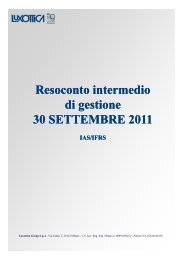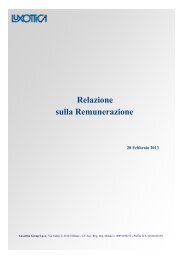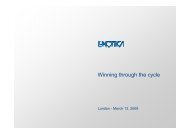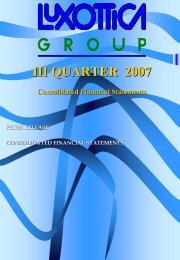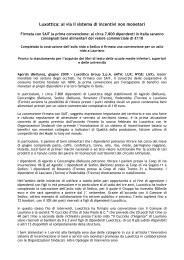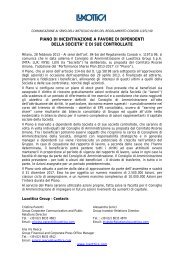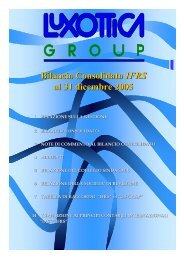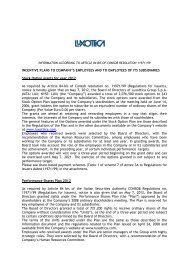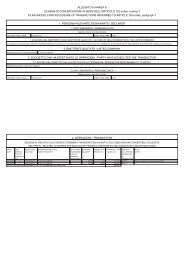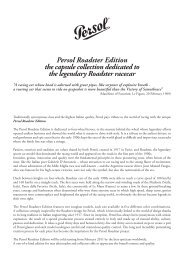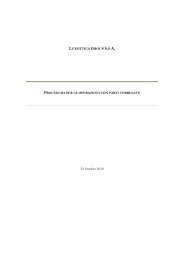Annual Review 2012 - Luxottica
Annual Review 2012 - Luxottica
Annual Review 2012 - Luxottica
Create successful ePaper yourself
Turn your PDF publications into a flip-book with our unique Google optimized e-Paper software.
74 |<br />
ANNUAL REPORT <strong>2012</strong><br />
With reference to compliance, in 2011 the position of Corporate Compliance Manager<br />
was created and a specific program was set-up and aimed at the mapping of the relevant<br />
areas of compliance for the Group and gaining an understanding of the level of maturity<br />
and protection of processes. On the basis of this program, specific compliance initiatives<br />
focused on Corporate Criminal Liability/Anti-Corruption, Privacy Data Management and<br />
Responsible Sourcing/Supply Chain Compliance were scoped, defined and developed<br />
in <strong>2012</strong> and these initiatives are expected to be completed in 2013. Throughout the<br />
course of the year work has continued on the definition of a comprehensive governance<br />
model for the Group’s Compliance function, aimed at achieving a more efficient, rational<br />
and pervasive monitoring of the processes and through subsequently reorganizing this<br />
function.<br />
From the viewpoint of the continuous process of applying the Internal Control System<br />
and Risk Management process to developments in operating conditions and legal and<br />
regulatory frameworks, the Company implemented a Financial Risk Policy, which was<br />
introduced in 2006 and revised most recently by the Board of Directors in October 2011,<br />
and is applicable to all the companies of the <strong>Luxottica</strong> Group.<br />
The policy sets forth the principles and rules for the management and monitoring of<br />
financial risk and pays particular attention to the activities carried out by the <strong>Luxottica</strong><br />
Group to minimize the risks deriving from the fluctuations of interest rates, exchange rates<br />
and the solvency of financial counterparties.<br />
The policy clarifies that the instrument used for “interest rate risk” hedging is the plain<br />
vanilla “interest rate swaps”, whereas for “exchange risk” “non-speculative” derivative<br />
instruments, such as “spot and forward exchange contracts” are used. In certain<br />
circumstances and subject to the specific authorization of the CFO, more flexible<br />
instruments that replicate the effect of the forward exchange contract or “zero cost collar”,<br />
“accumulator forward” and “average strike forward” can be used.<br />
The use of derivative instruments is aimed only at the actual hedging of exchange risk<br />
that the company is exposed to, therefore the use of these instruments for speculative<br />
purposes is not permitted. In addition to aiming at reducing counterparty risk, the policy<br />
specifies the minimum criteria to be met in order to be able to transact with the Group.<br />
This principle sets forth: the obligation to operate with qualified banking counterparties<br />
through standard agreements (Master Agreement ISDA), a limit on exposure per individual<br />
counterparty and a limit on the total exposure of the Group, as well as fixing the minimum<br />
credit credential requirements for the counterparties authorized to engage derivative<br />
transactions.<br />
A quarterly reporting system has also been implemented for the Control and Risk<br />
Committee since 2007 to highlight the debt exposure and the hedging transactions<br />
implemented to minimize “interest rate” risk, “exchange rate” risk and, since 2011,<br />
“counterparty risk”.<br />
Another operational and control instrument that has been implemented for some time is<br />
the Credit Policy, which is applicable to all the wholesale companies of <strong>Luxottica</strong> Group.



